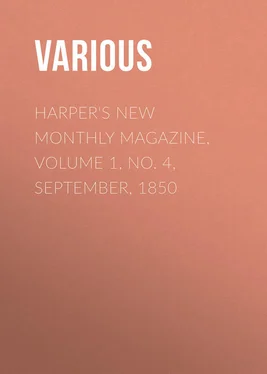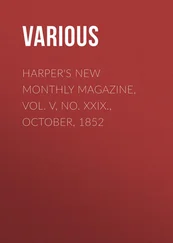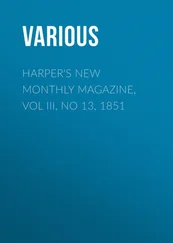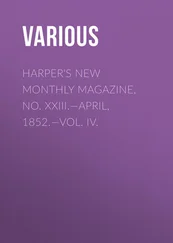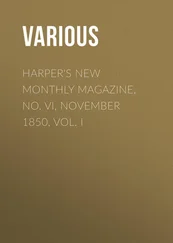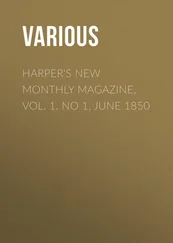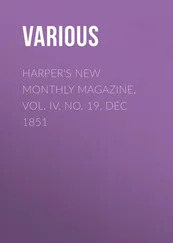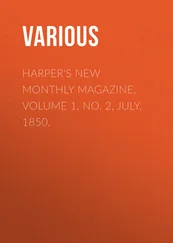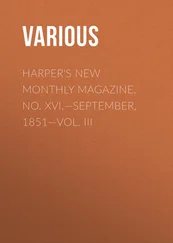Various - Harper's New Monthly Magazine, Volume 1, No. 4, September, 1850
Здесь есть возможность читать онлайн «Various - Harper's New Monthly Magazine, Volume 1, No. 4, September, 1850» — ознакомительный отрывок электронной книги совершенно бесплатно, а после прочтения отрывка купить полную версию. В некоторых случаях можно слушать аудио, скачать через торрент в формате fb2 и присутствует краткое содержание. Издательство: Иностранный паблик, Жанр: periodic, foreign_edu, на английском языке. Описание произведения, (предисловие) а так же отзывы посетителей доступны на портале библиотеки ЛибКат.
- Название:Harper's New Monthly Magazine, Volume 1, No. 4, September, 1850
- Автор:
- Издательство:Иностранный паблик
- Жанр:
- Год:неизвестен
- ISBN:нет данных
- Рейтинг книги:5 / 5. Голосов: 1
-
Избранное:Добавить в избранное
- Отзывы:
-
Ваша оценка:
- 100
- 1
- 2
- 3
- 4
- 5
Harper's New Monthly Magazine, Volume 1, No. 4, September, 1850: краткое содержание, описание и аннотация
Предлагаем к чтению аннотацию, описание, краткое содержание или предисловие (зависит от того, что написал сам автор книги «Harper's New Monthly Magazine, Volume 1, No. 4, September, 1850»). Если вы не нашли необходимую информацию о книге — напишите в комментариях, мы постараемся отыскать её.
Harper's New Monthly Magazine, Volume 1, No. 4, September, 1850 — читать онлайн ознакомительный отрывок
Ниже представлен текст книги, разбитый по страницам. Система сохранения места последней прочитанной страницы, позволяет с удобством читать онлайн бесплатно книгу «Harper's New Monthly Magazine, Volume 1, No. 4, September, 1850», без необходимости каждый раз заново искать на чём Вы остановились. Поставьте закладку, и сможете в любой момент перейти на страницу, на которой закончили чтение.
Интервал:
Закладка:
We now come to by far the most splendid display on record; which, as it was the third in successive years, and on the same day of the month as the two preceding, seemed to invest the meteoric showers with a periodical character; and hence originated the title of the November meteors. The chief scene of the exhibition was included within the limits of the longitude of 61° in the Atlantic Ocean, and that of 100° in Central Mexico, and from the North American lakes to the West Indies. Over this wide area, an appearance presented itself, far surpassing in grandeur the most imposing artificial fire-works. An incessant play of dazzlingly brilliant luminosities was kept up in the heavens for several hours. Some of these were of considerable magnitude and peculiar form. One of large size remained for some time almost stationary in the zenith, over the Falls of Niagara, emitting streams of light. The wild dash of the waters, as contrasted with the fiery uproar above them, formed a scene of unequaled sublimity. In many districts, the mass of the population were terror-struck, and the more enlightened were awed at contemplating so vivid a picture of the Apocalyptic image – that of the stars of heaven falling to the earth, even as a fig-tree casting her untimely figs, when she is shaken of a mighty wind. A planter of South Carolina, thus describes the effect of the scene upon the ignorant blacks: “I was suddenly awakened by the most distressing cries that ever fell on my ears. Shrieks of horror and cries for mercy I could hear from most of the negroes of three plantations, amounting in all to about six or eight hundred. While earnestly listening for the cause, I heard a faint voice near the door calling my name. I arose, and taking my sword, stood at the door. At this moment, I heard the same voice still beseeching me to rise, and saying, ‘O my God, the world is on fire!’ I then opened the door, and it is difficult to say which excited me most – the awfulness of the scene, or the distressed cries of the negroes. Upward of one hundred lay prostrate on the ground – some speechless, and some with the bitterest cries, but with their hands raised, imploring God to save the world and them. The scene was truly awful; for never did rain fall much thicker than the meteors fell toward the earth; east, west, north, and south, it was the same.”
This extraordinary spectacle commenced a little before midnight, and reached its height between four and six o’clock in the morning. The night was remarkably fine. Not a cloud obscured the firmament. Upon attentive observation, the materials of the shower were found to exhibit three distinct varieties: – 1. Phosphoric lines formed one class apparently described by a point. These were the most abundant. They passed along the sky with immense velocity, as numerous as the flakes of a sharp snow-storm. 2. Large fire-balls formed another constituency of the scene. These darted forth at intervals along the arch of the sky, describing an arc of 30° or 40° in a few seconds. Luminous trains marked their path, which remained in view for a number of minutes, and in some cases for half an hour or more. The trains were commonly white, but the various prismatic colors occasionally appeared, vividly and beautifully displayed. Some of these fire-balls, or shooting-stars, were of enormous size. Dr. Smith of North Carolina observed one which appeared larger than the full moon at the horizon. “I was startled,” he remarks, “by the splendid light in which the surrounding scene was exhibited, rendering even small objects quite visible.” The same, or a similar luminous body, seen at New Haven, passed off in a northwest direction, and exploded near the star Capella. 3. Another class consisted of luminosities of irregular form, which remained nearly stationary for a considerable time, like the one that gleamed aloft over the Niagara Falls. The remarkable circumstance is testified by every witness, that all the luminous bodies, without a single exception, moved in lines, which converged in one and the same point of the heavens; a little to the southeast of the zenith. They none of them started from this point, but their direction, to whatever part of the horizon it might be, when traced backward, led to a common focus. Conceive the centre of the diagram to be nearly overhead, and a proximate idea may be formed of the character of the scene, and the uniform radiation of the meteors from the same source. The position of this radiant point among the stars was near γ Leonis. It remained stationary with respect to the stars during the whole of the exhibition. Instead of accompanying the earth in its diurnal motion eastward, it attended the stars in their apparent movement westward. The source of the meteoric shower was thus independent of the earth’s rotation, and this shows its position to have been in the regions of space exterior to our atmosphere. According to the American Professor, Dr. Olmsted, it could not have been less than 2238 miles above the earth’s surface.
The attention of astronomers in Europe, and all over the world, was, as may be imagined, strongly roused by intelligence of this celestial display on the western continent; and as the occurrence of a meteoric shower had now been observed for three years successively, at a coincident era, it was inferred that a return of this fiery hail-storm might be expected in succeeding Novembers. Arrangements were therefore made to watch the heavens on the nights of the 12th and 13th in the following years at the principal observatories; and though no such imposing spectacle as that of 1833 has been witnessed, yet extraordinary flights of shooting stars have been observed in various places at the periodic time, tending also from a fixed point in the constellation Leo. They were seen in Europe and America on November 13th, 1834. The following results of simultaneous observation were obtained by Arago from different parts of France on the nights of November 12th and 13th, 1830:
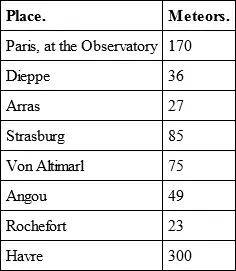
On November 12th, 1837, at eight o’clock in the evening, the attention of observers in various parts of Great Britain was directed to a bright, luminous body, apparently proceeding from the north, which, after making a rapid descent, in the manner of a rocket, suddenly burst, and scattering its particles into various beautiful forms, vanished in the atmosphere. This was succeeded by others all similar to the first, both in shape and the manner of its ultimate disappearance. The whole display terminated at ten o’clock, when dark clouds which continued up to a late hour, overspread the earth, preventing any further observation. In the November of 1838, at the same date, the falling stars were abundant at Vienna: and one of remarkable brilliancy and size, as large as the full moon in the zenith, was seen on the 13th by M. Verusmor, off Cherburg, passing in the direction of Cape La Hogue, a long, luminous train marking its course through the sky. The same year, the non-commissioned officers in the island of Ceylon were instructed to look out for the falling stars. Only a few appeared at the usual time; but on the 5th of December, from nine o’clock till midnight, the shower was incessant, and the number defied all attempts at counting them.
Professor Olmsted, an eminent man of science, himself an eye-witness of the great meteoric shower on the American continent, after carefully collecting and comparing facts, proposed the following theory: The meteors of November 13th, 1833, emanated from a nebulous body which was then pursuing its way along with the earth around the sun; that this body continues to revolve around the sun in an elliptical orbit, but little inclined to the plane of the ecliptic, and having its aphelion near the orbit of the earth; and finally, that the body has a period of nearly six months, and that its perihelion is a little within the orbit of Mercury. The diagram represents the ellipse supposed to be described, E being the orbit of the earth, M that of Mercury, and N that of the assumed nebula, its aphelion distance being about 95 millions of miles, and the perihelion 24 millions. Thus, when in aphelion, the body is close to the orbit of the earth, and this occurring periodically, when the earth is at the same time in that part of its orbit, nebulous particles are attracted toward it by its gravity, and then, entering the atmosphere, are consumed in it by their concurrent velocities, causing the appearance of a meteoric shower. The parent body is inferred to be nebular, because, though the meteors fall toward the earth with prodigious velocity, few, if any, appear to have reached the surface. They were stopped by the resistance of the air and dissipated in it, whereas, if they had possessed any considerable quantity of matter, the momentum would have been sufficient to have brought them down in some instances to the earth. Arago has suggested a similar theory, that of a stream or group of innumerable bodies, comparatively small, but of various dimensions, sweeping round the solar focus in an orbit which periodically cuts that of the earth. These two theories are in substance the Chladnian hypothesis, first started to explain the observed actual descent of aërolites. Though great obscurity rests upon the subject, the fact may be deemed certain that independently of the great planets and satellites of the system, there are vast numbers of bodies circling round the sun, both singly and in groups, and probably an extensive nebula, contact with which causes the phenomena of shooting stars, aërolites, and meteoric showers. But admitting the existence of such bodies to be placed beyond all doubt, the question of their origin, whether original accumulations of matter, old as the planetary orbs, or the dispersed trains of comets, or the remains of a ruined world, is a point beyond the power of the human understanding to reach.
Читать дальшеИнтервал:
Закладка:
Похожие книги на «Harper's New Monthly Magazine, Volume 1, No. 4, September, 1850»
Представляем Вашему вниманию похожие книги на «Harper's New Monthly Magazine, Volume 1, No. 4, September, 1850» списком для выбора. Мы отобрали схожую по названию и смыслу литературу в надежде предоставить читателям больше вариантов отыскать новые, интересные, ещё непрочитанные произведения.
Обсуждение, отзывы о книге «Harper's New Monthly Magazine, Volume 1, No. 4, September, 1850» и просто собственные мнения читателей. Оставьте ваши комментарии, напишите, что Вы думаете о произведении, его смысле или главных героях. Укажите что конкретно понравилось, а что нет, и почему Вы так считаете.
